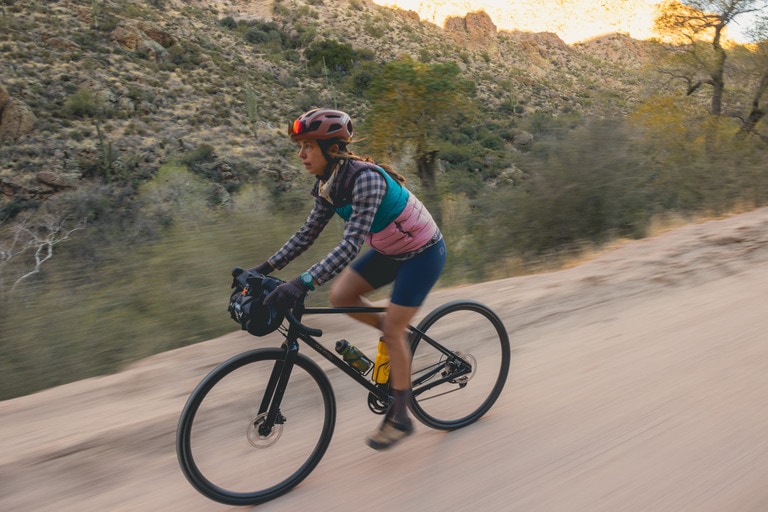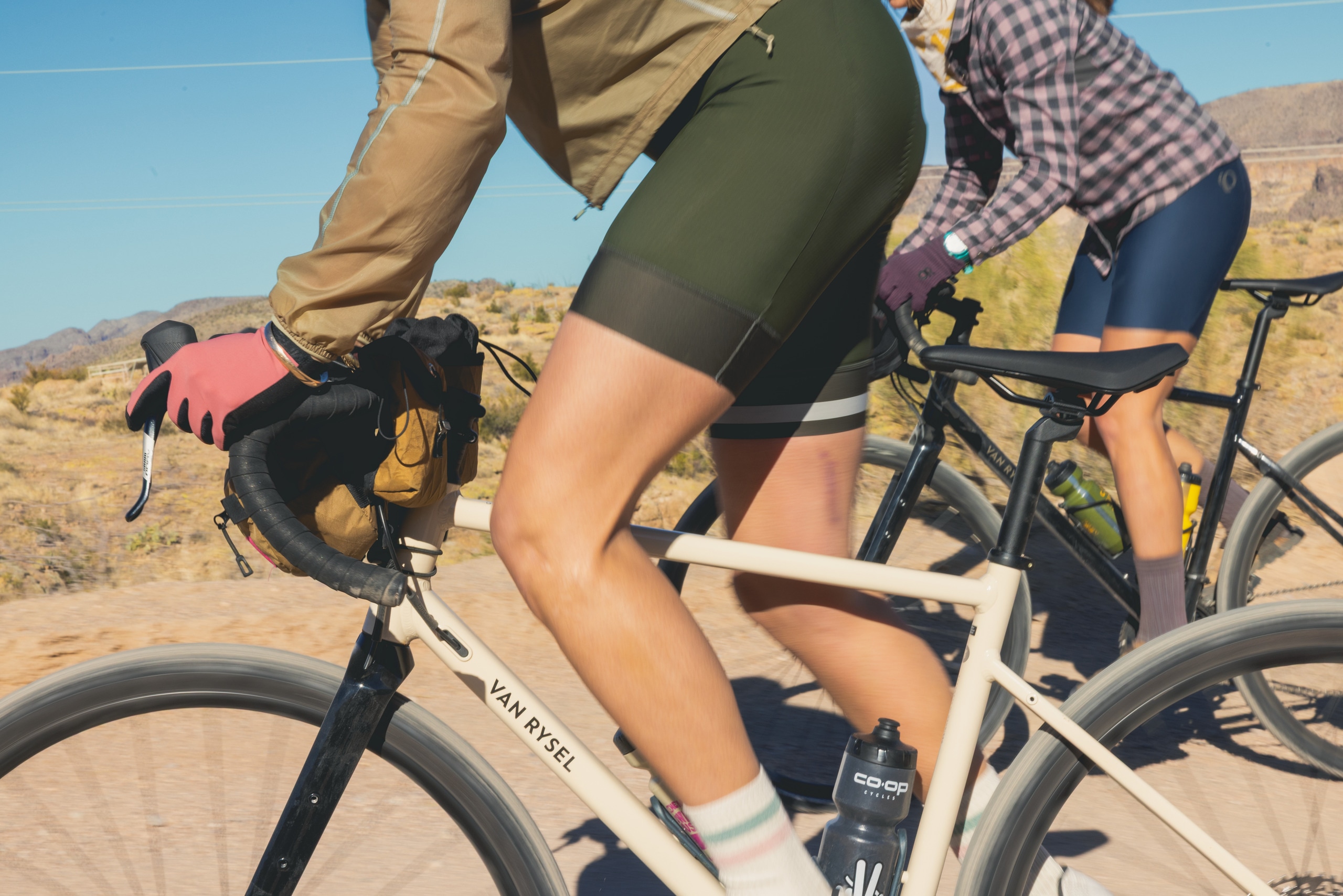As cycling grows in popularity, many riders are asking the same question: Which bike is the best fit for my adventures? Choosing between a road bike and a gravel bike comes down to a lot more than just looks—it's about how, where and why you ride.
Road bikes are built for efficiency and speed on smooth pavement, while gravel bikes are made to tackle dirt, gravel and mixed terrain. But there's a lot more that goes into choosing the best bike for you. To better understand the features that distinguish these bike types, we consulted experts in the field, including Brian Kelly, REI Co-op Cycling Manager; Nina Baum, Cannondale Global Product Manager; Claire Murphy, REI Co-op Bike Mechanic; and James Clarkson, REI Co-op Shop Manager. Here, they explain the basic makeup of each bike type and outline which key features to look for when shopping for your next ride.
Read on for the full article or click on the links below:
Features of a Road Bike
A road bike is built with one goal in mind: efficiency on pavement. At its core, the frame is lightweight and stiff, designed to transfer every pedal stroke into forward motion.
Road bikes are "designed with speed and aerodynamics in mind, resulting in generally a more 'aggressive' geometry," shares Murphy, an REI bike mechanic. This setup makes them the go-to choice for everything from racing to long-distance fitness rides. Road bikes use higher gears to help riders go fast on flats and downhills. The gears are typically closer together, allowing the rider to find just the right pedaling rhythm on fast, asphalt surfaces.

A quick glance at a road bike and a gravel bike next to each other will make the difference evident even to the untrained eye—the road bike has a sleek, unencumbered frame that's not bogged down with mounts beyond a water bottle cage. "Relative to a gravel bike, you’ll find shorter wheelbases, a steeper front end, and less room for big tires, which all add up to make a road bike feel lithe, responsive, and fast on any kind of pavement," says Baum.
While the road bike definitely wins out in the speed category, comfort can be a challenge for new riders due to its frame geometry. The frame of the bike is the area in the center between the wheels and below the seat and handlebars that forms a triangle with the head tube on top. A lower stack—the vertical distance from the center of the bottom bracket to the head tube—and more extended reach—the horizontal distance from the center of the bottom bracket to the head tube—put the rider in a crouched position, "which many folks might find less comfortable for long periods of time," says Murphy.
Features of a Gravel Bike

A gravel bike is designed for versatility, built to handle a mix of pavement, dirt and other loose surfaces. With a higher stack and a shorter reach, the rider sits at a more upright position. This allows for increased stability and comfort, while also keeping pressure off the hands.
The wheels and tires are what make a gravel bike shine off-road. Wider tire clearance accommodates treaded or semi-treaded tires, which are essential for traction. The extra air volume helps to absorb impact from bumps, roots and other rocky surfaces, reducing fatigue on all-day adventures. However, the gravel bike has a trade-off when considering speed: "Gravel tires provide grip and shock absorption but are slower on pavement," says Murphy.
Gravel bikes also feature handlebars and gearing that's tailored to mixed terrain. Compared to a road bike, a gravel bike will have a lower gear range to help riders climb steep or uneven trails without grinding to a halt. And because these bikes are built with adventure in mind, frames often include multiple mounts for bags, racks, fenders and extra bottles.
Keep in mind that a gravel bike is not a mountain bike. Mountain bikes are designed for technical off-road riding with suspension systems, flat handlebars and wide, knobby tires. "If you’re looking to hit their namesake gravel roads, forest roads or maybe some easy mountain bike trails, [a gravel bike] is probably your best option," according to Kelly, REI Co-op Cycling Manager. "On more challenging trails, you are definitely better off on a mountain bike."
How to Choose the Right Bike for You
If you are deciding between a road bike and a gravel bike, you might be wondering which is the best option for you. According to Murphy, the decision comes down to two questions:
What are your cycling goals?
Where do you plan to ride most often?
If your routes are primarily on paved roads and your priority is speed, efficiency and smooth handling, a road bike is hard to beat. The lightweight frame and aerodynamic riding position give riders a performance edge when chasing personal bests on local climbs and also allows them to be transported more easily. If you aspire to head out on weekend group rides or train for that next race, there's no better option than a road bike.
A gravel bike, on the other hand, shines when your riding takes you beyond the pavement. Mixed terrain is where a gravel bike shines, tapping into the wider tires, stable geometry and lower gearing. Gravel bikes also tend to provide a more comfortable ride due to their upright seating position and shock-absorbing tires. And, when the adventure bug strikes, gravel bikes can gear up for a bikepacking outing with multiple mounting options available.
New riders "may not know what they want to do with the bike," explains Kelly. "A gravel bike gives them the option to explore both road and off-road as they find out what type of riding they enjoy most." This flexibility can be particularly valuable for beginners who aren't willing to commit to a single style of riding. Instead of worrying about buying the "wrong" bike, they can start with one that covers a wide range of experiences—smooth pavement to commute to work, dirt paths on weekends, and the occasional overnight bikepacking trip.
That versatility also makes gravel bikes a popular choice for riders who value freedom and discovery over pure speed. By changing tires or adjusting setups, cyclists can adapt the same bike to new environments. For example, you can use slick, narrower tires for commuting, and then switch to a wide, knobbier tire at a lower pressure for weekend trail rides. Over time, many riders find that a gravel bike not only meets them where they are but also grows with them as their interests evolve.
Crossover and Hybrid Bike Options
If pavement riding is your priority but you are willing to sacrifice some speed in exchange for comfort, Kelly suggests you explore the sub-category of road sport/endurance/all-road bikes. "Not everyone is in pursuit of the fastest times, and sport/all-road bikes are a great compromise for a little more comfort." These bikes can tackle rougher roads and loose gravel, though not to the extent that a gravel bike can.

When compared to a road bike, sport/endurance bikes offer a more relaxed frame geometry, increasing stability and comfort. "The rider is put in a less aggressive position on the bike in comparison to a more performance-oriented bike, but with still a nod towards riding performance," says Kelly.
The higher tire clearance allows for a bigger and cushier tire (again, more comfort) than a road bike. "Just know that you won’t have quite the same comfort or traction that you would get from a wider gravel tire," reminds Kelly. Additional accessory mounts make adding a rack or fenders a possibility.
Try Both Road and Gravel Riding
What is a good option for riders who want to enjoy both road and gravel riding but don't want to invest in two bikes? "For someone who wants one bike to do it all, a gravel bike is a perfect choice," shared Clarkson, "because with a change of tires, you can easily ride the road. A gravel bike also gives you the option to ride gravel or bike pack."
This versatility is what has made gravel bikes so popular in recent years. Riders can swap out wide, knobby tires for smooth, narrow ones and suddenly have a bike that feels quick and efficient on pavement. Switch them back, and you're ready to tackle long mixed-terrain adventures or even multi-day bikepacking trips. However, you'll never get the full aerodynamics of a road bike or the suspension of a mountain bike. Still, for cyclists who split time between road and dirt, or who simply want the freedom to explore without worrying about terrain, this one-bike solution often makes the most sense.
Murphy agrees, sharing: "I only steer someone toward a road bike if they’re certain they’ll be doing long-distance rides, group rides, races, or charity events exclusively on smooth pavement, and want to prioritize speed and efficiency." Road bikes still have the edge when it comes to pure performance. Their lighter frames, stiffer builds and tighter gearing give them a natural advantage for fast group rides or pushing personal records. But unless that’s your only focus, a gravel bike’s adaptability often delivers more value and enjoyment.
Our Experts
Nina Baum, a Gravel Product Manager at Cannondale Bicycles, is a multi-time national champion across various off-road cycling disciplines. Now based at Cannondale’s headquarters in Connecticut, she makes frequent trips back home to the Rocky Mountains as well as traveling the world to pursue the global pulse of gravel.
James Clarkson is an REI bike shop manager with over 30 years of cycling experience as a shop owner, mechanic and racer.
Brian Kelly is a product manager with Co-op Cycles, the bicycle brand by REI Co-op. He has been working on product strategy for nearly 20 years. At REI, he is responsible for developing product strategy for cycling gear, from kids’ bikes and gravel rides to cycle accessories. What started as a simple used bike purchase to get around in college led to years of building and tinkering with, and now developing, bikes.
Kate Loweth, an REI Co-op Member and gear tester based in California, has been writing about the outdoors, travel and parenting for over a decade. Her work can be found in National Geographic, AAA, AARP, Viator, SUCCESS magazine and other publications.
Claire Murphy is a bike mechanic at REI in Raleigh, North Carolina.

